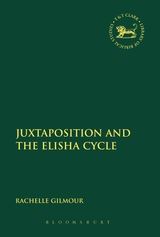Gilmour, Rachelle. Juxtaposition and the Elisha Cycle. LBHOTS 594. New York/London: Bloomsbury, 2015, pp. 250, $110, cloth ($26, e-book).
Rachelle Gilmour is Lecturer in Biblical Studies at the Broken Bay Institute in Sydney. She earned her Ph.D. in Hebrew Bible from the University of Sydney and spent time at both the Hebrew University and University of Edinburgh as a postdoctoral fellow. During her time at the Hebrew University, she wrote the monograph Juxtaposition and the Elisha Cycle. Gilmour has written broadly regarding literary analysis in the Former Prophets, with most of her work focused specifically in Samuel and Kings.
Gilmour contends that a gaping hole exists in Old Testament literary critical studies around what she considers to be an essential tool of the writers of the Hebrew Bible, namely, juxtaposition. Juxtaposition is the deliberate, redactional selection and arrangement of scenes, episodes, and even whole narratives, next to other units with the intent to guide the reader to a different interpretation than one would discover if a unit was read independently. To correct this problem, Gilmour provides in this monograph a theoretical framework for interpreters of the Hebrew Bible to understand juxtaposition of narratives as a critical part of the hermeneutical task.
She arranges the book into three parts: methodology, application, and concluding remarks. In part A, Gilmour critiques both diachronic criticism’s pragmatic explanation of juxtaposition as well as literary criticism’s insufficient utilization of juxtaposition as a tool to explain the text only when contradictions of chronology or ideology exist in the text. Instead, she points to clear inner-biblical allusions, as well as 2nd Temple rabbinical hermeneutical practice, to show that juxtaposition is a legitimate and important hermeneutical lens for the writers of the Hebrew Bible. Thus, arrangement of the juxtaposed elements is itself a hermeneutical process that can change the interpretation of whole narratives. She maintains, “Attention to juxtaposition is not merely a method for explaining particular discontinuities in biblical narrative but is a principle of interpretation for all narrative” (p. 18).
After establishing her argument for the need of a proper framework for understanding and analyzing this phenomenon, Gilmour (following rabbinic tradition) suggests analyzing the two ways the writers of the Hebrew Bible utilized juxtaposition: chronological and non-chronological interpretation. Literary units that are primarily juxtaposed together based on chronological sequence build a plot that points the reader to interpret a cause-effect relationship, but they can also be juxtaposed for background information.
Gilmour applies Bakhtin’s literary approach of Dialogism to non-chronological juxtaposition. Dialogism is truth expressed via multiple voices through interaction and discussion rather than by one person. Non-chronological units can be juxtaposed to create a dialogue between units of contradiction, corroboration, or question and answer. Since non-chronological units do not have a cause-effect relationship, the dialoguing connections between units must be found in repeated words or phrases, parallel plots and narrative analogy, or Mise-en-Abyme (a story embedded in the narrative that contains the plot of the larger narrative in microcosm). Finally, Gilmour clarifies how to discern continuity (chronological sequence) and discontinuity (non-chronological sequence) in the narrative.
After laying the foundations of her methodological framework, she applies this approach to the Elisha cycle in Part B. Gilmour assumes a putative redaction history, with two separate collections of Elisha stories with other smaller stories added after being brought together with the Elijah cycle, which “…will demonstrate how the interpretation of episodes can be transformed when placed in a new context, even if we are not able to describe with complete accuracy the process behind the formation of the Elisha cycle” (p. 73). Gilmour then proceeds episode by episode in the Elisha cycle, starting in 1 King’s 19:19-21, and compares the interpretation of each episode by itself, then when juxtaposed with the preceding passage, subsequent passage, and putative original position in pre-existing collections to demonstrate the significance of the author’s choice in juxtaposing units.
In the final section, Part C, Gilmour concludes her monograph by applying the Bakhtinian criteria for dialoguing voices (corroboration, contradiction, and question and answer) to the task of the interpreter rather than the original author(s). Paying attention to juxtaposition as a hermeneutical lens helps explain the function of strange stories and details that, when read independently, seem irrelevant or inexplicably inappropriate (such as the episode of Elisha, the 42 boys and the mauling by bears). Additionally, an awareness of the intentionality of juxtaposition aids in identifying the focus of an episode and in clarifying ambiguous situations. With the Elisha cycle particularly, Gilmour demonstrates how utilizing this approach presents a fresh analysis of these narratives leading to a more complex and nuanced appreciation of Elisha, the Elijah cycle and Jehu narratives, as well as their placement and function in the book of Kings.
Juxtaposition and the Elisha Cycle is a helpful and badly needed resource for Old Testament literary criticism; yet more work remains to be done as Gilmour’s work is only applied to the Elisha cycle. For those who have a working knowledge of Hebrew as well as an introductory level understanding of Old Testament literary criticism, Rachelle Gilmour’s sections on a methodological framework for juxtaposition (Part A) and concluding remarks on its usefulness to biblical narrative (Part C) are critical and her argument needs to be considered. Many pastors and most lay leaders, however, will not find this book accessible, as its cost and subject matter might prove too esoteric to be immediately beneficial. This monograph is not a commentary-type resource on 2 Kings which most preachers or Sunday School leaders could reference in weekly preparation. Nevertheless, I recommend this resource to any biblical studies student who desires to either study the Elisha cycle specifically or the literary phenomena and hermeneutical strategy of juxtaposition generally.
Michael Prevett
Gordon-Conwell Theological Seminary




